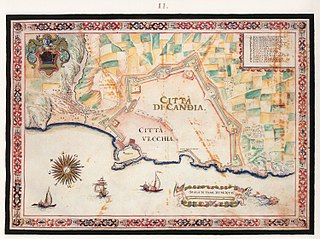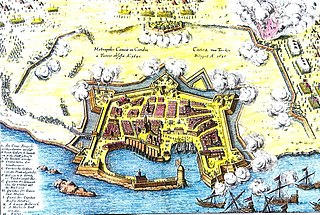This battle took place on 26 May 1646 at the mouth of the Dardanelles Strait, during the Cretan War. The Ottoman fleet under the Kapudan Pasha, Kara Musa Pasha, tried to defeat the Venetian fleet, under Tommaso Morosini. The Venetians were blockading the Dardanelles, trying thus to prevent reinforcements and supplies to be brought to Crete, a Venetian possessions which the Ottomans had invaded the previous year, and to disrupt the flow of supplies to the Ottoman capital, Constantinople.
This battle took place on 21 June 1655 inside the mouth of the Dardanelles Strait. It was a clear victory for Venice over the Ottoman Empire during the Cretan War.

The Third Battle of the Dardanelles in the Fifth Ottoman-Venetian War took place on 26 and 27 June 1656 inside the Dardanelles Strait. The battle was a clear victory for Venice and the Knights Hospitaller over the Ottoman Empire, although their commander, Lorenzo Marcello, was killed on the first day.
This battle was fought on 10 July 1651, with some minor fighting on 8 July, between the islands of Paros and Naxos in the Aegean Sea, between the Venetian and Ottoman fleets. It was a Venetian victory, but failed to achieve anything decisive.

The Morean war, also known as the Sixth Ottoman–Venetian War, was fought between 1684–1699 as part of the wider conflict known as the "Great Turkish War", between the Republic of Venice and the Ottoman Empire. Military operations ranged from Dalmatia to the Aegean Sea, but the war's major campaign was the Venetian conquest of the Morea (Peloponnese) peninsula in southern Greece. On the Venetian side, the war was fought to avenge the loss of Crete in the Cretan War (1645–1669). It happened while the Ottomans were entangled in their northern struggle against the Habsburgs – beginning with the failed Ottoman attempt to conquer Vienna and ending with the Habsburgs gaining Buda and the whole of Hungary, leaving the Ottoman Empire unable to concentrate its forces against the Venetians. As such, the Morean War was the only Ottoman–Venetian conflict from which Venice emerged victorious, gaining significant territory. Venice's expansionist revival would be short-lived, as its gains would be reversed by the Ottomans in 1718.

The Seventh Ottoman–Venetian War was fought between the Republic of Venice and the Ottoman Empire between 1714 and 1718. It was the last conflict between the two powers, and ended with an Ottoman victory and the loss of Venice's major possession in the Greek peninsula, the Peloponnese (Morea). Venice was saved from a greater defeat by the intervention of Austria in 1716. The Austrian victories led to the signing of the Treaty of Passarowitz in 1718, which ended the war.

The Cretan War, also known as the War of Candia or the fifth Ottoman–Venetian war, was a conflict between the Republic of Venice and her allies against the Ottoman Empire and the Barbary States, because it was largely fought over the island of Crete, Venice's largest and richest overseas possession. The war lasted from 1645 to 1669 and was fought in Crete, especially in the city of Candia, and in numerous naval engagements and raids around the Aegean Sea, with Dalmatia providing a secondary theater of operations.

The Fourth Ottoman–Venetian War, also known as the War of Cyprus was fought between 1570 and 1573. It was waged between the Ottoman Empire and the Republic of Venice, the latter joined by the Holy League, a coalition of Christian states formed by the pope which included Spain, the Republic of Genoa, the Duchy of Savoy, the Knights Hospitaller, and the Grand Duchy of Tuscany.

The First Ottoman–Venetian War was fought between the Republic of Venice with its allies and the Ottoman Empire from 1463 to 1479. Fought shortly after the capture of Constantinople and the remnants of the Byzantine Empire by the Ottomans, it resulted in the loss of several Venetian holdings in Albania and Greece, most importantly the island of Negroponte (Euboea), which had been a Venetian protectorate for centuries. The war also saw the rapid expansion of the Ottoman navy, which became able to challenge the Venetians and the Knights Hospitaller for supremacy in the Aegean Sea. In the closing years of the war, however, the Republic managed to recoup its losses by the de facto acquisition of the Crusader Kingdom of Cyprus.

The siege of Corfu took place on 8 July – 21 August 1716, when the Ottoman Empire besieged the city of Corfu, on the namesake island, then held by the Republic of Venice. The siege was part of the Seventh Ottoman–Venetian War, and, coming in the aftermath of the lightning conquest of the Morea by the Ottoman forces in the previous year, was a major success for Venice, representing its last major military success and allowing it to preserve its rule over the Ionian Islands.
Canım Hoca Mehmed Pasha was an 18th-century Ottoman admiral of Greek origin who served three times as Kapudan Pasha.
The siege of Negroponte was undertaken by the forces of the Republic of Venice from July to October 1688. The Venetian army, composed of several mercenary and allied contingents from western Europe, had succeeded in capturing the Peloponnese in the previous years, and proceeded to capture Athens and attack Negroponte, the main Ottoman stronghold in Central Greece. The Venetian siege was hampered by the Ottoman resistance and their inability to completely isolate the town, as the Ottoman general Ismail Pasha managed to ferry supplies to the besieged garrison. Furthermore, the Venetian army suffered many casualties from an outbreak of the plague in the Venetian camp, which led to the death of 4,000 troops and the experienced general Otto Wilhelm Königsmarck. The departure of the Florentine and Maltese contingents further weakened the Venetians, and when the German mercenaries refused to remain there in winter quarters, the Venetian commander, Doge Francesco Morosini, had to concede defeat and retreat to the Peloponnese.

The fortifications of Chania are a series of defensive walls and other fortifications which surround the city of Chania in Crete, Greece. The inner city walls were first built in antiquity, and were rebuilt by the Byzantine Empire. The outer walls were built in the 16th century by the Republic of Venice. Some of the fortifications were demolished in the 20th century, but parts of both the Byzantine and Venetian walls remain intact.

The siege of Santa Maura took place on 21 July – 6 August 1684 between the forces of the Republic of Venice and the Ottoman Empire, and was the opening battle of the Sixth Ottoman–Venetian War. From his base at Corfu the Venetian commander-in-chief, Francesco Morosini, led a fleet of 38 galleys, 8 galleasses and several auxiliary vessels to besiege the Fortress of Santa Maura on the island of Lefkada, that was under Ottoman rule. The besieging forces were swelled by Greek levies and volunteers from the Ionian Islands. The siege lasted until 6 August, when the commander Bekir Agha, bowing to pressure from the 500 Albanians and 200 Greeks in the fortress garrison, surrendered to the Venetians.
The Ottoman reconquest of the Morea took place in June–September 1715, during the Seventh Ottoman–Venetian War. The Ottoman army, under Grand Vizier Silahdar Damat Ali Pasha, aided by the fleet under Kapudan Pasha Canım Hoca Mehmed Pasha, conquered the Morea peninsula in southern Greece, which had been captured by the Republic of Venice in the 1680s, during the Sixth Ottoman–Venetian War. The Ottoman reconquest inaugurated the second period of Ottoman rule in the Morea, which ended with the outbreak of the Greek War of Independence in 1821.
Giovanni Dario was a Venetian official who served multiple times as ambassador of the Republic of Venice. His family hailed from Crete, a Venetian colony at the time; his knowledge of Greek allowed him to serve as interpreter and envoy to Constantinople during the last years of the Byzantine Empire. After the Fall of Constantinople he rose to the position of secretary of the Duke of Crete, and from 1464 entered service with the Signoria of Venice. He was repeatedly sent as ambassador to the court of the Ottoman Empire and the Mamluk Sultanate, most notably helping conclude the First Ottoman–Venetian War in 1479.

The siege of Chania happened during the initial stages of Cretan War (1645–1669). The Ottomans besieged the Venetian-held city of Chania, and after 56 days of siege, the Ottomans captured the city.

The siege of Lemnos happened during the Cretan War when the Ottomans launched a campaign to reconquer the island of Lemnos from the Venetians. The Ottomans captured the island in the end.

The siege of Chania in 1660 was an attempt by the Christian forces to recapture the city from the Ottoman hold. The Ottoman managed to thwart the Christian attempt to capture the city.
The Battle of Chania took place on 14 August 1646, when the fleet of the Republic of Venice and her allies, under Giovanni Cappello, tried to destroy the Ottoman ships at anchor in the port of Chania, on Crete. The attack was a failure, as the Venetians could not penetrate the harbour defences.












